- MOE
- National Parks of Japan
- Towada-Hachimantai National Park
- Characteristics
main body
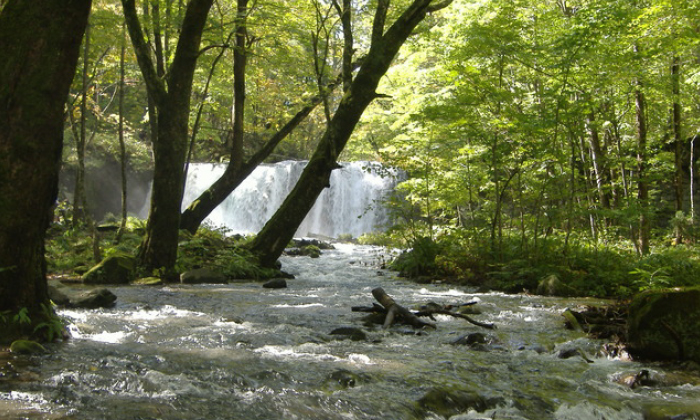
Characteristics
Michinoku’s Mountain Range
— Serene Lake colored by the virgin forests, live volcanoes and hot spring resorts in the depth of the mountains.
Date of Designation: February 1, 1936
Area: 85,534 ha
Related Prefectures: Aomori, Akita, Iwate
Area: 85,534 ha
Related Prefectures: Aomori, Akita, Iwate
Towada-Hachimantai National Park is located in the mountainous region of Northern Honshu, and is made up of the Towada-Hakkoda region with Mt. Hakkoda, Lake Towada, and Oirase-Keiryu (a moutain stream) and the Hachimantai region with Mt. Hachimantai, Mt. Akita-Komagatake, and Mt. Iwate and it is a park of mountains, lakes, and streams.
In the Towada-Hakkoda region, you can enjoy constantly changing scenery throughout the season of the year, such as Lake Towada with its mysterious beauty, the gentle and pure flow of the Oirase-Keiryu, Mt. Hakkoda with its famous Juhyo (frost covered trees), and the diverse flora and fauna nurtured in the rich natural environment. The Hachimantai region is one of Japan's most famous volcanic areas. This attractive park is filled with numerous lakes, marshes, and moors and a diverse ecosystem created over a long period of time from the combination of the volcanic phenomena and the snowy conditions of the winter.
Another attraction of this park is the numerous hot springs.
In the Towada-Hakkoda region, you can enjoy constantly changing scenery throughout the season of the year, such as Lake Towada with its mysterious beauty, the gentle and pure flow of the Oirase-Keiryu, Mt. Hakkoda with its famous Juhyo (frost covered trees), and the diverse flora and fauna nurtured in the rich natural environment. The Hachimantai region is one of Japan's most famous volcanic areas. This attractive park is filled with numerous lakes, marshes, and moors and a diverse ecosystem created over a long period of time from the combination of the volcanic phenomena and the snowy conditions of the winter.
Another attraction of this park is the numerous hot springs.
Terrain/ Scenery

Lake Towada
Towada-Hakkoda Area
Lake Towada is a caldera lake formed by volcanic activity that began approximately 200,000 years ago. The quiet lake surface and the rich greenery that covers the area from the lakeside to the somma create a primeval landscape and this place is designated as Japan's Special Place of Scenic Beauty and a Natural Monument. The mysterious view that changes with the seasons from a variety of perspectives such as the lakeside footpath and sightseeing boats on the lake, as well as the viewpoints on the somma, fascinates many visitors of the area. In addition to the Yasumiya-Yasumitai area at the base of the Nakayama Peninsula, there are many footpaths, sightseeing boat docks, and camping sites scattered around the lakeside that are crowded with many visitors.
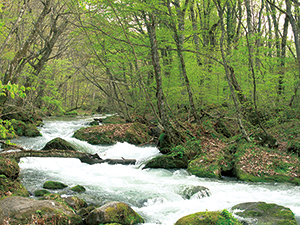
Oirase-Keiryu
Oirase-Keiryu (a mountain stream)
The Oirase-Keiryu is a U-shaped valley approximately 14 km long that was carved out by the Oirase River, which is the only river that flows out of Lake Towada. Not only the clarity of the water flowing in the stream, but also the constantly changing flow, mossy rocks, forests of giant trees that cover the banks, and numerous waterfalls that flow over the rock face all come together to create one of the most scenic locations in Japan, and these are the reasons why Oirase Mountain Stream is designated as Japan's Special Place of Scenic Beauty and a Natural Monument. The spring and autumn foliage is particularly stunning, and the footpath maintained along the entire mountain stream is crowded with many tourists.
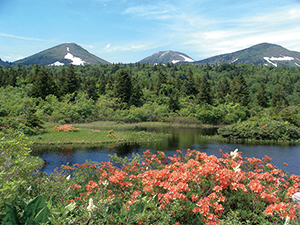
Mt. Hakkoda and Suiren Pond
Hakkoda Mountain Range
The highest peak in the Hakkoda Mountain Range is Mt. Odake with a height of 1,585 m and the mountain range spans this group of volcanoes from Mt. Takada-Odake and Mt. Akakura, to the Kushigamine, Komagamine, Mt. Norikura, and Mt. Yokodake that continue on to the south. You can observe excellent flora in the natural forests of Japanese beech and Aomori-Todomatsu trees that covers that mountains, and the alpine plants and moors of the mountain ridges. These mountains have properly maintained hiking trails as well as a ropeway that runs year round, and the area attracts tourists even in the winter with alpine skiing and the Juhyo (frost covered trees). Additionally, at the foot of the mountains are numerous quaint hot springs, such as the Jogakura, Sukayu, Sarukura, Yachi, and Tsuta onsens and is a popular area for hot spring therapy.
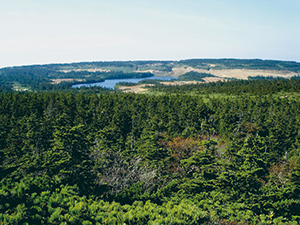
Hachimantai
Hachimantai Area
Hachimantai is a volcanic plateau formed by multiple volcanoes, and is dotted with lakes, marshes, and moors, such as the Hachiman Pond, and calm, majestic mountain landscapes. You can drive your car up to around Mikaeri Pass, and at the summit and around Hachiman Pond there are footpaths and viewpoints that are popular with many visitors. At the base of the mountains are Goshogake onsen, Fukenoyu onsen, and Toshichi onsen where you can observe the fumes and hot spring fountains, and mud volcano phenomena, and where the numerous hot springs scattered in the area are popular for hot spring therapy.
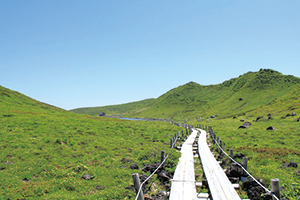
Mt. Akita-Komagatake
Mt. Akita-Komagatake
Located on the southern end of this park, it is formed by a group of volcanoes such as Mt. Akita-Komagatake and Mt. Nyuto. Among them, Mt. Akita-Komagatake is the collective name for the highest peak, Mt. Oname (1,637 m above sea level), and multiple somma and caldera crater hills such as Mt. Odake, Mt. Yokodake, and Mt. Medake. Well known as a treasure trove of alpine plants such as the Dicentra peregrina and Takanesumire (Viola crassa), and the area near the summit is designated a special protection area and protected as a Natural Monument of Japan. Additionally, the Nyuto onsen and Kunimi onsen found on the hillside are popular hot springs filled with a rustic atmosphere.
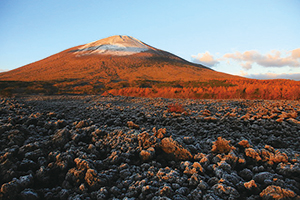
Mt. Iwate and Yakebashiri lava flow
Mt. Iwate
Mt. Iwate (2,038 m above sea level) is a stratovolcano made up of two volcanoes, Mt. Higashi-Iwate and Mt. Nishi-Iwate and is the highest mountain in Iwate Prefecture. Located a distance away from the main ridges of Ou Mountains such as Mt. Hachimantai and Mt. Akita-Komagatake, and because particularly when viewed from the east side, you can see a broad base and clean mountain form that is almost like a single peak mountain, this mountain is also called Nambu-Kata Fuji. There is a 360-degree view from the summit, where you can see Mt. Akita-Komagatake, Mt. Hachimantai, and Mt. Hayachine as well as Mt. Chokai in the distance. The Ohachimawari is a route that takes you around the crater wall at the summit, and there are many Kannon statues, remnants of mountain's long history as a place of worship. Additionally, along the northeast base is the Yakebashiri lava flow, a rocky field formed by lava that spilled from the hillside, that is also designated a Special Natural Monument of Japan.
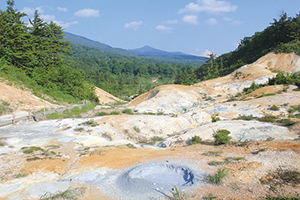
Goshogake
Volcanic landforms
This park is located in one of the most famous volcanic regions in Japan. Mt. Hakkoda, located in the Towada- Hakkoda region is divided into North Hakkoda volcano group around Mt. Odake and the South Hakkoda volcano group around Mt. Kushigamine, and is composed of more than 20 volcanoes. The Hachimantai region with Mt. Iwate, Mt. Akita-Komagatake, and Mt. Hachimantai is composed of about 40 diverse volcanoes. There are also many crater lakes, such as Lake Towada, a caldera lake formed by volcanic activities, and Hachiman Pond. The Hachimantai region also has Goshogake and Tamagawa area where visitors can observe volcanic phenomena such as fumes and mud volcanoes up close, giving it the name "Volcano Museum."
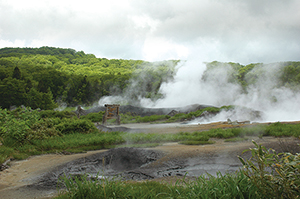
Oyunuma
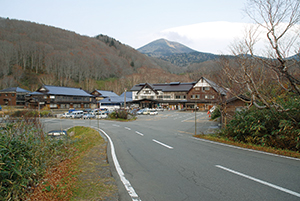
Sukayu Onsen
Hot Springs
Located in a volcanic region, this park has numerous hot springs. The hot springs scattered around the foot of Mt. Hakkoda and Mt. Hachimantai in particular boast abundant quantity and each hot spring resort has its own unique atmosphere.
Plants
Vegetation of the park is mainly deciduous trees such as Japanese beech and oak, but conifers including Abies mariesii can be seen at the tops of Mt. Hakkoda and Mt. Hachimantai. The Abies mariesii forest has adapted to the snowy environment and its density and spread are both one of the most impressive examples in Japan, and particularly in the winter, a fantastic view is created by the Juhyo (frost covered trees). Additionally, on the ridgeline you can see a variety of alpine plant communities and marsh plant communities, with different beautiful flowers blooming depending on the season.
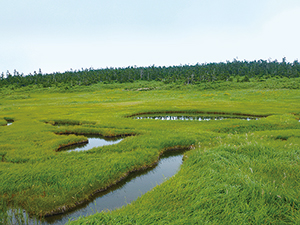
Wetland Plant Communities and Abies Mariesii Forest (Hachimantai Summit)
Wildlife
Blessed with a rich habitat, a wide variety of animals live here including mammals such as the Asiatic black bear, Japanese serow, the Dormouse and Japanese flying squirrel which depend on a rich forest environment for survival, amphibians such as the forest green tree frog, black salamander, rare species of birds such as black woodpecker and migratory birds such as the ruddy kingfisher and Siberian blue robin, and insects such as the Ezoharuzemi and Ruriitotombo .
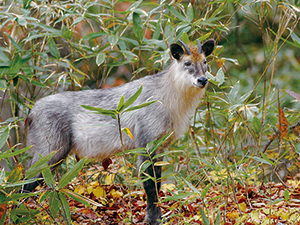
Japanese Serow
